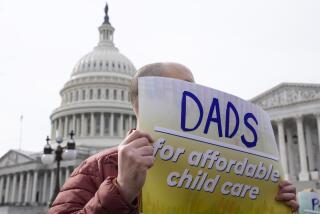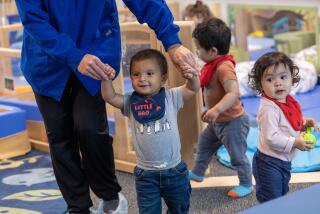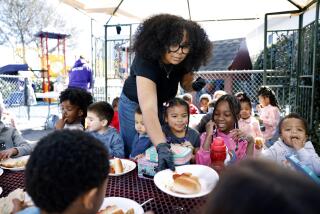Children in Day Care Get More Illnesses
Ron Haskins, a developmental psychologist, and Jonathan Kotch, a pediatrician, have nothing against day care. Indeed, Haskins put his own three children in day care when they were younger and would do so again.
But after he and Kotch reviewed more than 150 scientific studies for the University of North Carolinaâs Bush Institute for Child and Family Policy, they reached an inescapable conclusion: Children in day care get more infectious illnesses--especially sore throats, colds, hepatitis A, bacterial meningitis and probably otitis media, a middle ear inflammation--than other preschoolers.
Does this mean that the United States will be swept by epidemics associated with day care? Most unlikely, Haskins and Kotch believe. According to their report, published earlier this year by the American Academy of Pediatrics, âMost day-care facilities are usually safe places for children, and the overwhelming majority of children will not suffer adverse consequences if the current situation persists.â
Still, it worries the reportâs authors that with almost 5 million preschool youngsters now in day care and the number likely to be 6.3 million by 1990, the problem is not getting the attention they think it deserves.
Medical Care Expensive
For one thing, they point out, taking sick preschool children to doctors is expensive, as are drugs and hospitalization, if required. For another, pay is often sacrificed when a working mother or father has to take time off to stay home with the little invalid.
Then, too, day-care staff, parents and other members of the household are quite likely to fall ill themselves with whatever ails the child; they are often sicker when they do.
For example, preschoolers with hepatitis A typically have few, if any obvious symptoms. But older people with this liver infection must be hospitalized and usually need two to three weeks of bed rest. Overall, day-care associated illness is costing individuals and the economy billions of dollars a year.
Turning the clock back to the days when most mothers of young children were housewives, say the authors, is not the answer. There are too many single working parents and families dependent on two incomes.
In an ideal world, regulation and frequent inspection of day-care facilities would go a long way to reduce this burden. However, there are more than a million day-care facilities in this country, making this impractical. The United States is one of the few industrialized nations with no real commitment to day care. This is unlikely to change in the near future.
Parentsâ Concerns
A key part of the answer, Haskins and Kotch suggest, is a change in parental attitudes. Studies have shown that parents choosing day care understandably put the location of the facility and its costs first. Health and safety considerations rank lower on their list of concerns.
There are basically two kinds of day care. One is family day care, which is generally run by a woman in her own home who has a young child and takes in one or two more. The other is the day-care center, which typically is more formal and has a larger enrollment.
Both kinds, Haskins and Kotch say, should have written health policies that parents get copies of and allow parents to drop in unannounced whenever they wish.
It is also important that kitchen and bathroom areas not be next to each other. Obviously, diapering areas should be in a separate area away from meal preparation and consumption.
âOther things being equal,â Haskins says, â3-, 4- and 5-year-olds are better off in day-care facilities that do not accept infants still in diapers. At the very least, centers that accept both infants and older preschoolers should have different staffs for them and keep the two age groups apart.â
Spreading Diseases
The reason is that diarrhea and hepatitis A, two of the chief day care health risks, are spread in feces. The risk is minimized when the diapering area is disinfected after each use. Soiled diapers and washcloths should be stored in closed containers that are emptied each day and kept out of the childrenâs reach.
A good day-care facility will also train its staff and children to wash their hands after going to the toilet and diapering an infant. Hands must also be washed before food preparation or handling. A rigorous scientific study found that regular hand washing with warm water and soap halves childhood diarrhea rates.
Because respiratory infections are often spread by droplets on the hands, hand-washing helps to prevent colds and sore throats, too.
Other things to look for include easy-to-clean surfaces, smoke detectors, fire extinguishers and capped electrical outlets, as well as outdoor play areas that are free of poisonous plants and litter. Bathrooms should have toilets and basins that are easy for a child to use. Because injuries also pose a risk to children, playground and other equipment should be safe.
Cribs with net sides or fitted with hanging mobiles that a child or infant could reach should be avoided. According to Haskins, children have been known to suffocate in the netting when they get their heads stuck in a corner of the crib. Babies can choke if, as has happened, they try to grab a mobile and in the process get the cord twisted around their necks.
Immunizations Recommended
Finally, day-care facilities should insist that children be immunized against measles, mumps, rubella (German measles), polio, diphtheria, whooping cough and tetanus.
The Centers for Disease Control also recommends immunization against hemophilic influenza bacteria for any day-care child at least 18 months old and for all children at age 2. The vaccine is more effective for 2- to 5-year-olds than for younger children, but it begins to confer some protection at a 18 months.
Despite their name, these germs do not cause influenza. Instead, they are an important cause of childhood meningitis, pneumonia, blood poisoning, arthritis and croup. Most children survive these infections, but many of them are permanently physically or intellectually impaired and some are both.
If much of this sounds obvious, it does not bother Haskins and Kotch. Their message is that parents do not need medical training to evaluate the health aspects of day-care centers; what they need is informed common sense.
More to Read
Sign up for Essential California
The most important California stories and recommendations in your inbox every morning.
You may occasionally receive promotional content from the Los Angeles Times.










